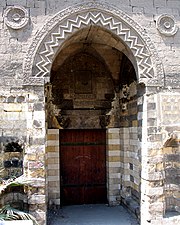Ablaq
Ablaq (Arabic: أبلق; particolored; literally 'piebald'[1]) is an architectural technique involving alternating or fluctuating rows of light and dark stone.
[3] The Dome of the Rock in Jerusalem, originally built in the late 7th century during the Umayyad period, features ablaq light and dark stone voussoirs in the arches of its inner colonnade.
[6] Andrew Petersen, a scholar of Islamic art and archeology, states that ablaq (alternating courses of white limestone and black basalt) is "a characteristic of the monumental masonry of Damascus.
[9] It also appears in the portals of some 13th-century Seljuk monuments in Konya, such as the Alaeddin Mosque the Karatay Madrasa, possibly due to the influence of Syrian craftsmen.
[3] Ablaq masonry supplemented other decorative techniques such as the use of "joggled" voussoirs in arches, where stones of alternating colours were cut into interlocking shapes.
[18] The technique of alternating light and dark stone constructions also appeared in Christian Europe around the mid 12th century, but it is uncertain whether this development occurred independently or was influenced by existing examples in Syria.
[3] Pisan ecclesiastical monuments—particularly the Cathedral of Pisa and Church of San Sepolcro (commenced building 1113)—used ablaq, not simple "black and white in revetment" between the conquest of Jerusalem in the First Crusade (1099) and the completion of the latter ca.





